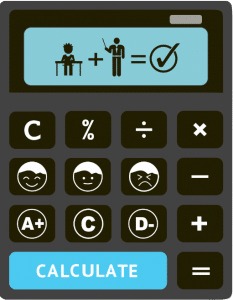If you’re studying for your HSC Maths exam, then you know that trigonometric functions will likely be a big part of the syllabus. This article will look at some basic concepts that will get you up and running with trig functions.
Learning Outcomes
By the time you finish reading this article, you should have an idea of
- The relationship between degrees and radians
- How to find the length of an arc on a circle, given its radius and the central angle
- How to find the area of a sector of a circle, given its radius and the central angle
- The unit circle and how to find any trig ratio of any angle between 0° and 360°
- Graphs of the six trig functions
Relationship between Degrees and Radians
There are two main ways to measure angles: in degrees or radians. These are units of measurement like any other quantity. Although most people are more familiar with measuring angles in degrees, radians are extensively used in trigonometry and calculus.
Radians are a bit more technical; they’re a unitless way of measuring angles based on the ratio of the length of an arc to the radius of a circle. Imagine going around a circle covering a distance equal to the circle’s radius. The angle swept is equal to 1 radian, as shown in the figure below.
There are 2π radians in a full circle.
So we have 2π radians = 360°
Use the relationship above to convert between degrees and radians.
In short, to convert from degrees to radians, divide the number of degrees by 180 and multiply by π. So, 45° would become
To convert from radians to degrees, multiply the number of radians by 180 and divide by π. So, \(\frac{\pi }{6}\) radians would become
\(\frac{\pi }{6}\times \frac{180^{\circ}}{\pi }=30^{\circ}\)
Length of an Arc on a Circle
An arc is a portion of the circumference of a circle. The length s of an arc of a circle with radius r that subtends an angle θ radians at the centre (see figure below) is given as s = r θ
Area of a Sector of a Circle
A sector of a circle is the portion of the circle enclosed by two radii and the intervening arc. The area of a sector of a circle of radius r that subtends an angle θ radians at the centre (see figure below) is given as
\(A=\frac{1}{2}\theta r^{2}\)
Trigonometric Functions using the Unit Circle
You must know the six trigonometric functions – sine, cosine, tangent, cotangent, secant, and cosecant. You have learned how to work with these functions in a right-angled triangle. In other words, you know these functions can be used for an angle between 0° and 90°, right? But did you know you can use these functions on any angle measure – more than 90° or even less than 0°?
That’s right, and we take the help of the unit circle to learn those concepts.
The unit circle is a circle with a radius of 1 unit and is centred at the origin (0,0) on a coordinate plane.
The idea is this: for any point on the circle, let θ denote the angle between the radius through that point and the positive x-axis, as shown below. Then, the x-coordinate of the point is given by cos θ, and the y-coordinate is given by sin θ. So, once you know these two, you can find any of the remaining four trig functions for that angle, as they are all related.
The complete unit circle is shown below. You will do yourself a big favour if you start familiarising yourself with the figure below right away!
Let us help you prepare for your Year 11 Trigonometry!
Graphs of Trigonometric Functions
In this section, we will take a quick look at the graphs of all six trig functions in the range between
-2π (-360°) and 2π (360°).
Graph of y = sinx
Graph of y = cosx
Graph of y = tanx
Graph of y = cotx
Graph of y = secx
Graph of y = cscx
Take some time to familiarise yourself with the graphs above. These graphs, especially the first three, will come up again and again throughout your year 11 and 12 maths curriculum. Also, make a note of the following:
- The sine and cosine of any angle always lie between -1 and 1 inclusive. This makes sense. As we have seen in right triangle trigonometry, both have the length of the hypotenuse, which is the longest side in a right-angled triangle, in the denominator.
- There is no lower or upper limit to the value of the tangent or cotangent of an angle.
- Secant and cosecant, being the reciprocals of sine and cosine, respectively, never lie between -1 and 1 exclusive.
Wrap Up
Trigonometry finds much use outside of the heights and distances you have learned. In real life, not all angles are restricted between 0° and 90°. The quicker you get accustomed to trigonometry beyond right-angled triangles, the better it is for you! If you’re still struggling to get your head around them, don’t hesitate to contact a tutor or friend for help.

















